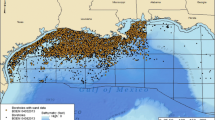Abstract
This paper is concerned with the estimation of a parametric probabilistic model of the random displacement source field at the origin of seaquakes in a given region. The observation of the physical effects induced by statistically independent realizations of the seaquake random process is inherent with uncertainty in the measurements and a stochastic inverse method is proposed to identify each realization of the source field. A statistical reduction is performed to drastically lower the dimension of the space in which the random field is sought and one is left with a random vector to identify. An approximation of the vector components is determined using a polynomial chaos decomposition, solution of an optimality system to identify an optimal representation. A second order gradient-based optimization technique is used to efficiently estimate this statistical representation of the unknown source while accounting for the non-linear constraints in the model parameters. This methodology allows the uncertainty associated with the estimates to be quantified and avoids the need for repeatedly solving the forward model.
Similar content being viewed by others
References
Biros G, Ghattas O (2005) Parallel Lagrange-Newton-Krylov-Schur methods for PDE-constrained optimization. Part I: The Krylov-Schur solver. J Sci Comput 27(2): 687–713
Desceliers C, Ghanem R, Soize C (2006) Maximum likelihood estimation of stochastic chaos representations from experimental data. Int J Numer Methods Eng 66: 978–1001
Desceliers C, Soize C, Ghanem R (2007) Identification of chaos representations of elastic properties of random media using experimental vibration tests. Comput Mech 39(6): 831–838
Douglas C, Haase G, Iskandarani M (2003) An additive Schwarz preconditioner for the spectral element ocean model formulation of the shallow water equations. Elec Trans Numer Anal 15: 18–28
Eggermont P, LaRiccia V (2001) Maximum penalized likelihood estimation. In: Density estimation, vol I. Springer, New York, 532 pp
Ghanem R, Spanos P (1990) Polynomial chaos in stochastic finite elements. J Appl Mech 57(1): 197–202
Ghanem R, Spanos P (2003) Stochastic finite elements: a spectral approach, revised edn. Dover, New York, 222 pp
Gilbert J, Lemaréchal C (1989) Some numerical experiments with variable-storage quasi-Newton algorithms. Math Program 45: 407–435
Hyvärinen A (1999) Survey on independent component analysis. Neural Comput Survey 2: 94–128
Iskandarani M, Haidvogel D, Boyd J (1995) A staggered spectral element model with application to the oceanic shallow water equations. Int J Numer Methods Fluids 20(5): 393–414
Koutsourelakis P (2009) A multi-resolution, non-parametric, bayesian framework for identification of spatially-varying model parameters. J Comput Phys 228(17): 6184–6211
Marzouk Y, Najm H (2009) Dimensionality reduction and polynomial chaos acceleration of Bayesian inference in inverse problems. J Comput Phys 228(6): 1862–1902
Marzouk Y, Najm H, Rahn L (2007) Stochastic spectral methods for efficient Bayesian solution of inverse problems. J Comput Phys 224(2): 560–586
Owen A, Zhou Y (1998) Adaptive importance sampling by mixtures of products of beta distributions. Technical report, Stanford University, 24 pp
Soize C (2010) Identification of high-dimension polynomial chaos expansions with random coefficients for non-Gaussian tensor-valued random fields using partial and limited experimental data. Comput Methods Appl Mech Eng 199(33–36): 2150–2164
Soize C, Desceliers C (2010) Computational aspects for constructing realizations of polynomial chaos in high dimension. SIAM J Sci Comput 32(5): 2820–2831
Soize C, Ghanem R (2009) Reduced chaos decomposition with random coefficients of vector-valued random variables and random fields. Comput Methods Appl Mech Eng 198: 21–26
Wang J, Zabaras N (2004) A Bayesian inference approach to the inverse heat conduction problem. Int J Heat Mass Transf 47(17–18): 3927–3941
Webb A (2002) Statistical pattern recognition, 2nd edn. Wiley, New York, p 496
Zabaras N, Ganapathysubramanian B (2008) A scalable framework for the solution of stochastic inverse problems using a sparse grid collocation approach. J Comput Phys 227(9): 4697–4735
Author information
Authors and Affiliations
Corresponding author
Rights and permissions
About this article
Cite this article
Mathelin, L., Desceliers, C. & Hussaini, M.Y. Stochastic data assimilation of the random shallow water model loads with uncertain experimental measurements. Comput Mech 47, 603–616 (2011). https://doi.org/10.1007/s00466-010-0560-7
Received:
Accepted:
Published:
Issue Date:
DOI: https://doi.org/10.1007/s00466-010-0560-7




